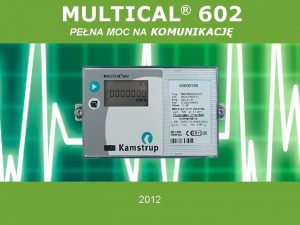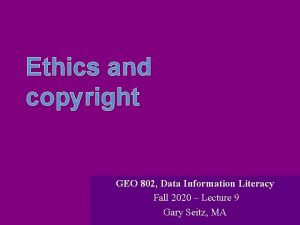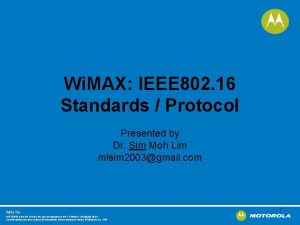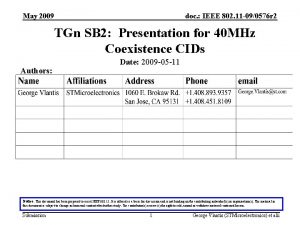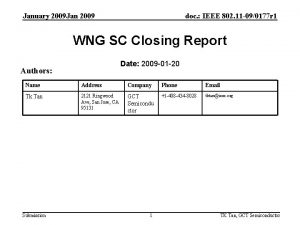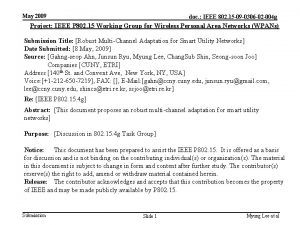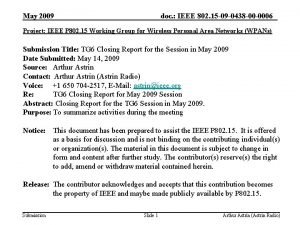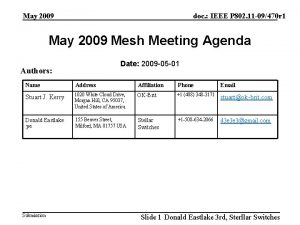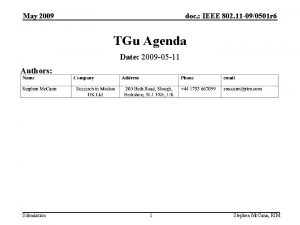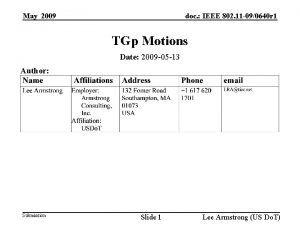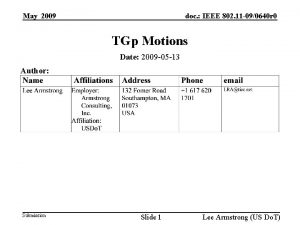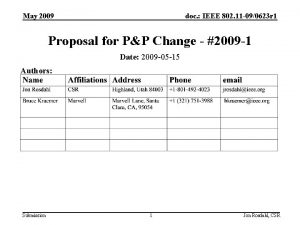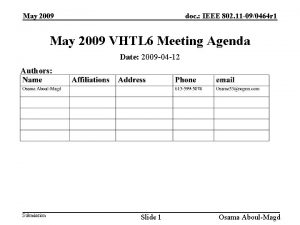May 2009 doc IEEE 802 11 090576 r














- Slides: 14

May 2009 doc. : IEEE 802. 11 -09/0576 r 1 TGn SB 2: Presentation for 40 MHz Coexistence CIDs Authors: Date: 2009 -05 -11 Notice: This document has been prepared to assist IEEE 802. 11. It is offered as a basis for discussion and is not binding on the contributing individual(s) or organization(s). The material in this document is subject to change in form and content after further study. The contributor(s) reserve(s) the right to add, amend or withdraw material contained herein. Submission 1 George Vlantis (STMicroelectronics) et alii

May 2009 doc. : IEEE 802. 11 -09/0576 r 1 Abstract • This presentation accompanies the motion contained in Document Number IEEE 802. 11 -09/0511 r 1 which contains a resolution to address the following Sponsor Ballot (SB) comments: – (SB 0) 27, 165, 168, 14, 129, 171, 47, 6, 42, 167, 9, 37, 31, 39, 17, 86, 1, 2, 3, 89, 179, 41, 38, 36, 55, 11, 5, 8, 30, 127, 155, 46, 157, 166, 170, 156, 128, 132, 125, 85, 56, 182, 183, 173, 4, 13, 7, 131, 239, 130, 32, 35, 122, 40, 84, 45, 29, 184, – (SB 1) 1070, 1001, 1062, 1061, 1059, 1046, 1005, 1006, 1007, 1008, 1009, 1045, 1063, 1044, 1060, 1069 – (SB 2) 2016, 2024, 2023, 2022, 2021, 2015, 2014 • The changes marked in this document are based on TGn Draft version P 802. 11 n D 9. 0. pdf. Submission 2 George Vlantis (STMicroelectronics) et alii

May 2009 doc. : IEEE 802. 11 -09/0576 r 1 Contents • Review of Editorial Instructions in the Motion • Discussion of the Editorial Instructions • Interpretations of “detecting the presence of” and “coexistence mechanism” • Summary Submission 3 George Vlantis (STMicroelectronics) et alii

May 2009 doc. : IEEE 802. 11 -09/0576 r 1 1 st Editorial Instruction: • TGn Editor to add new paragraph before NOTE 1 in 11. 14. 4. 1, page 236, between lines 32 and 33, as follows: In addition to the restrictions on transmission of 40 MHz mask PPDUs found in subclause 11. 14. 4. 1 to 11. 14. 4. 4, if a STA operating in the 2. 4 GHz ISM band has no means of determining the presence of non 802. 11 communication devices operating in the area, then the STA shall not transmit any 40 MHz mask PPDUs. Submission 4 George Vlantis (STMicroelectronics) et alii

May 2009 doc. : IEEE 802. 11 -09/0576 r 1 2 nd Editorial Instruction: • TGn Editor change the NOTE 2 paragraph in 11. 14. 4. 1, page 236, lines 36 and 39, move the text above NOTE 1, as follows: NOTE 2 — In addition to the restrictions on transmission of 40 MHz mask PPDUs found in subclauses 11. 14. 4. 1 (Field used to determine 40 MHz PPDU transmission restrictions) to 11. 14. 4. 4 (Restrictions on non-AP STAs that are not a member of an infrastructure BSS), if a STA operating in the 2. 4 GHz ISM band has knowledge means of determining the presence of non-802. 11 communication devices operating in the area and determines that non-802. 11 communications devices are operating in the area, then it is recommended that either no non-802. 11 communication device is operating in the area or that non-802. 11 communication devices are operating in the area but the STA implements a coexistence mechanism for these non-802. 11 communication devices, then the STA may transmit 40 MHz mask PPDUs, otherwise, the STA shall not transmit any 40 MHz mask PPDUs. Submission 5 George Vlantis (STMicroelectronics) et alii

May 2009 doc. : IEEE 802. 11 -09/0576 r 1 Discussion • Two new phrases are introduced (which will be elaborated in this presentation): 1) “has means of determining the presence of” (replacing “has knowledge of”) 2) “coexistence mechanism” • The 1 st Editorial Instruction addresses the case where coexistence is not addressed in a deployment. In this case: – – – – Submission The text is consistent with WFA “out-of-the-box” restrictions on 40 MHz transmissions in the 2. 4 GHz ISM band. No new protocols are introduced between STA and AP. No new scanning procedures are introduced. The collisions observed in the (approximate 10 foot) locality of a transmitting STA and a transmitting non-802. 11 device are averted. No usage of the “ 40 MHz Intolerant Bit” in the HT Control Field field is advocated: it was concluded that the usage of this bit is overkill, i. e. 40 MHz transmissions would be prohibited throughout the BSS and neighboring. 11 n BSSs unnecessarily. The STA’s up-link is restricted, but not the down-link to the STA nor transmission by any other STA in the BSS. The STA “silently” decides not to exercise the 40 MHz transmission option. 6 George Vlantis (STMicroelectronics) et alii

May 2009 doc. : IEEE 802. 11 -09/0576 r 1 Discussion (cont’d) • The 2 nd Editorial Instruction addresses the case where coexistence is addressed in a deployment. In this case: – 40 MHz transmission in 2. 4 GHz ISM band are allowed under one of two conditions: • • – • A STA has “determined that the presence of a non-802. 11 communication device” is not true, i. e. they are absent in the locality A STA has “determined that a non-802. 11 communication device(s) are present”, but the STA has a “coexistence mechanism” to mitigate transmission collisions in the locality. Otherwise, they are prohibited. “Determining the presence of” and “coexistence mechanism” are not defined rigorously, but several opportunities are considered: 1) Human Deployment 2) Software 3) Hardware 4) System Submission 7 George Vlantis (STMicroelectronics) et alii

May 2009 doc. : IEEE 802. 11 -09/0576 r 1 “Means of detecting the presence” and “Coexistence mechanism” interpretation 1) Human Deployment – – Submission Currently, WFA prohibits transmitting 40 MHz mask frames “out-of-thebox”. An IT professional or savvy deployer of 802. 11 n, who is savvy enough to enable the 40 MHz feature should be savvy enough to be aware of his channel allocations in 2. 4 GHz and the presence of BT devices in his home/enterprise. 40 MHz bands would not be overlapped to cover the entire band Another Example: An 802. 11 n AP wanting to do 40 MHz transmissions would not be collocated with a non-802. 11 device transmitting in the 2. 4 GHz band. The “non-802. 11 communication detector” or “coexistence mechanism”, in this case would be the sensible judgment of the human deployer. 8 George Vlantis (STMicroelectronics) et alii

May 2009 doc. : IEEE 802. 11 -09/0576 r 1 “Means of detecting the presence” and “Coexistence mechanism” interpretation 2. Software – Applications (e. g. SKYPE) that deal with headsets can interrogate whether their connectivity to the Internet is WLAN (or wired or whatever) from the O/S – Operating Systems for PCs (e. g. Windows, Linux) and O/S for handsets (Symbian, Android, etc. ) have an awareness of the usage of headsets and WLAN and would control the transmission of 40 MHz frames through the driver. – Power management schemes for WLAN and BT in handsets typically enable the WLAN and BT devices through an extension of the Packet Traffic Arbiter (PTA) in 802. 15. 2. So the power management software itself is aware when BT and WLAN are both active and would throttle the transmission of 40 MHz mask frames. Submission 9 George Vlantis (STMicroelectronics) et alii

May 2009 doc. : IEEE 802. 11 -09/0576 r 1 “Means of detecting the presence” and “Coexistence mechanism” interpretation 3. Hardware – 802. 15. 2 (Clause 6) Packet Traffic Arbiter (PTA) activity – Idle BT or other non-802. 11 device are available for detection and coexistence. – 802. 11 CCA carrier sense power threshold. – Power levels in FFT bins – Any other yet-to-be designed, yet-to-be-deployed sensors Submission 10 George Vlantis (STMicroelectronics) et alii

May 2009 doc. : IEEE 802. 11 -09/0576 r 1 “Means of detecting the presence” and “Coexistence mechanism” interpretation 4. System – There is a recognition that a system supplier who wants to delight his customer will take some of the steps above to mitigate interference. There is also a recognition that the 802. 11 "stack" is not vertically integrated (as with BT), and therefore no forum (even Wi-Fi Alliance) is chartered to do the work. The second paragraph of the text can be interpreted as an opportunity to do a better job on any or all levels. – The "last resort" is for an 802. 11 n STA to set the "40 MHz Intolerant" bit which has the consequence of disabling 40 MHz in the STA's BSS and any overlapping 802. 11 n BSS. It’s overkill for a local congestion issue, and should not be mandated. Submission 11 George Vlantis (STMicroelectronics) et alii

May 2009 doc. : IEEE 802. 11 -09/0576 r 1 Summary • • The first paragraph of text addresses the case where the STA has no "method of detection" of non-802. 11 devices. The consequence would be that 40 MHz transmission is prohibited. on the "uplink", but not on the "downlink", which is consistent with all test results. The “ 40 MHz Intolerant” bit is not advocated. The text is consistent with WFA. The second paragraph of text addresses the case where the STA does “detect the presence of non-802. 11 devices” and either senses the presence of none or has a means to mitigate interference. No particular mechanism is mandated. It is an opportunity for deployment, software, hardware and systems to better coexist with non 802 -11 communication devices. Submission 12 George Vlantis (STMicroelectronics) et alii

May 2009 doc. : IEEE 802. 11 -09/0576 r 1 Straw Poll Question: Do you support adopting the Editorial Instructions in Doc. #802. 11 -09/0511 r 1 into 802. 11 n Draft 10. 0 for Sponsor Ballot Recirculation #3? Yes: No: Abstain: Submission 13 George Vlantis (STMicroelectronics) et alii

May 2009 doc. : IEEE 802. 11 -09/0576 r 1 Motion Move to adopt the Editorial Instructions in Doc. #802. 11 -09/0511 r 1 into 802. 11 n Draft 10. 0 for Sponsor Ballot Recirculation #3? Motioned: Seconded: Yes: No: Abstain: Submission 14 George Vlantis (STMicroelectronics) et alii












